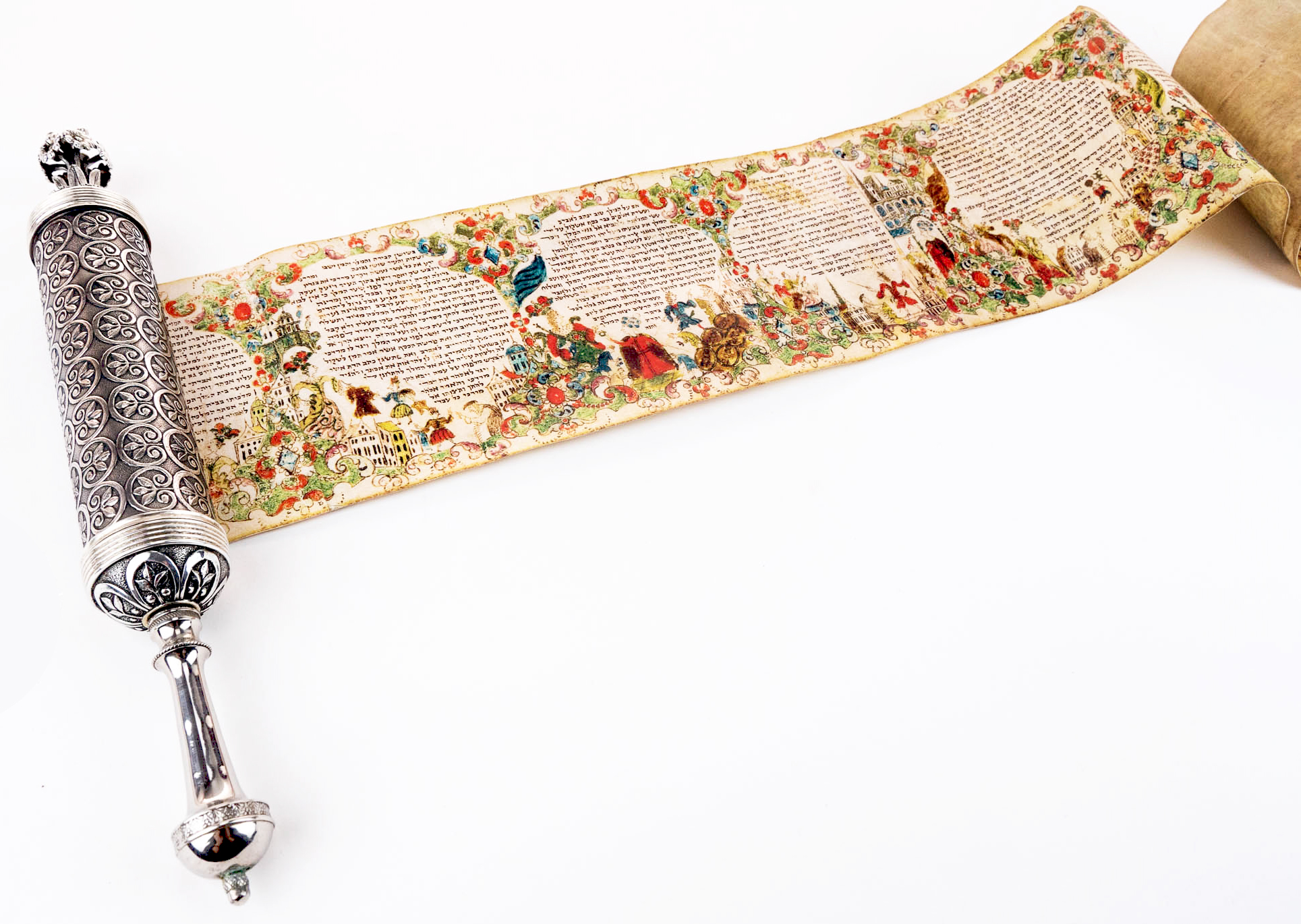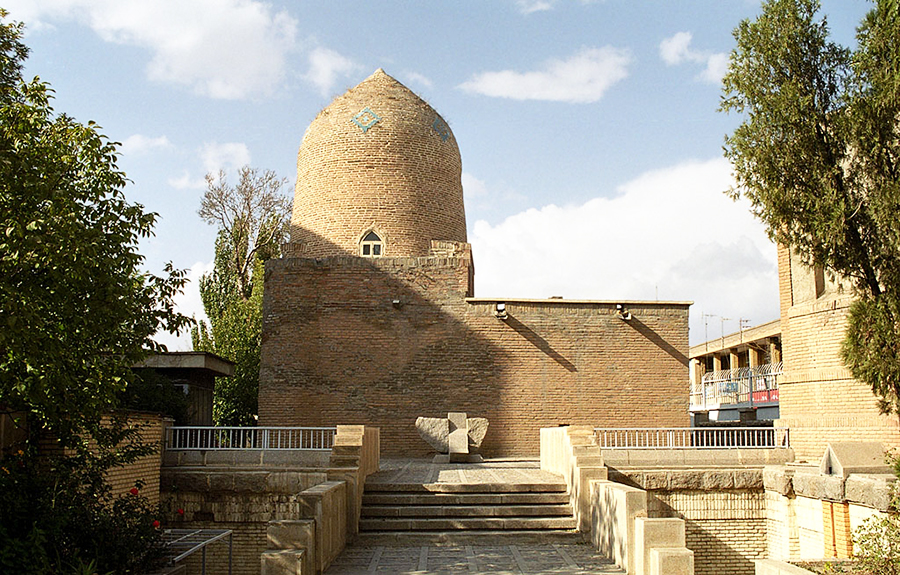
Bible, History, Archaeology
Bible,
History,
Archaeology
Queen Esther in Susa,
the Book of Esther
The Book of Esther
He is the most famous of the five meguiloth (a subdivision of the Ketuvim, other «Sacred Writings» of the Hebrew Bible).
See the Books of the Old Testament page →
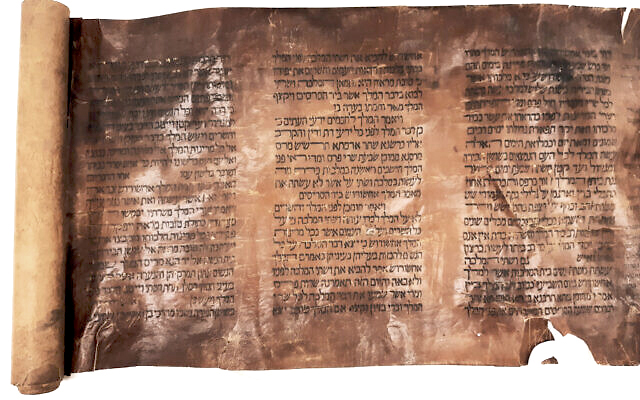
Image opposite: a very old scroll from the Book of Esther, dating from 1465, donated to the French National Library. It was written in the Iberian Peninsula. National Library of Israel.
The central character of the book is a young girl named Esther, but also Hadassa. Hadassa is a Hebrew name meaning myrtle. As for Esther, the name derives either from the Greek asthèr (star), or Ishtar, name of the Babylonian goddess of love. So she had two names, like many Hebrews in exile (cf. Daniel and his friends).
Esther appears in Scripture as a woman of great piety, characterized by her faith, wisdom, courage, patriotism, prudence and resolution. She is faithful and obedient to her uncle Mordecai, who took her in and brought her up.
Image opposite: an artistic illustration of a king of the Persian Empire at the end of the 5th century BC © DR.
Mordekai (Mordechai) is the Hebrew form of the Babylonian name Marduka, a Theophoric name formed from Marduk, the main deity of the Babylonian pantheon. He is the son of Yair, a typically Hebrew name (eg: Numbers 32,41), from the tribe of Benjamin, one of the two tribes that made up the Kingdom of Judah before its destruction by the Neobabylonians and the deportations of the kingdom's elite to the provinces of the Neobabylonian empire.
A text discovered at Borsippa speaks of a minister of the king named Marduk or Mordekai, precisely at this time. Is this the same character? One wonders. We also know (cuneiform tablets, etc.) that many Jewish exiles rose to high office in the Persian Empire.
A facsimile of an ancient book or scroll of Esther (Hebrew: מגילת אסתר Meguillah Esther) dating from the 16th century. It is the twenty-first book of the Hebrew Bible. It is one of the Ketuvim according to Jewish tradition and Historical books of the Old Testament according to Christian tradition. Facsimilefinder Edition.
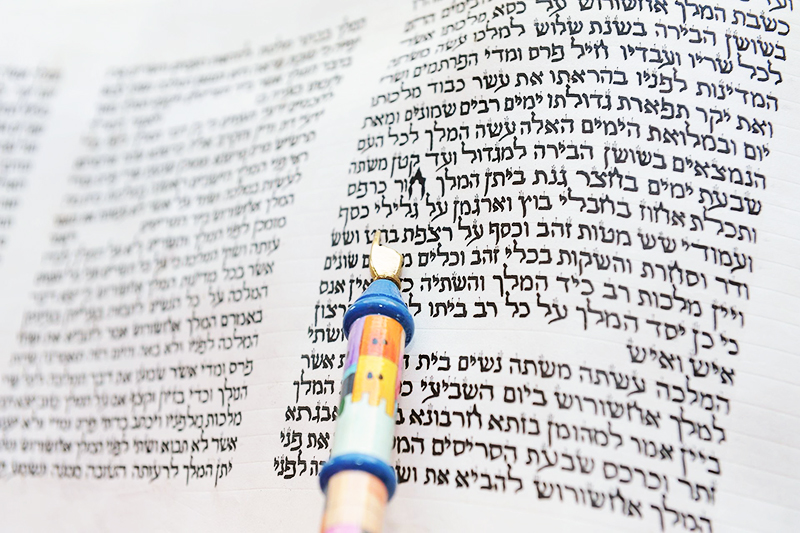
It was written after the reign of Ahasuerus (c. 465) and before the writing of the Second book of the Maccabees which mentions the day of Mordekai. The most common date of writing is the Persian period.
Image opposite: reading a manuscript of Esther with a yad (reading pointer for liturgical use, designed for reading the Torah from the Sifrei Torah parchment. The yad is designed to prevent unwanted contact with the parchment, since, according to the Talmud, Holy Writ makes hands impure). © D.R.
This explains why his language and style are similar to those of late books such as’Ezra, Nehemiah and Chronicles. It contains several Persian words. The author, certainly a Persian Jew, must have had access to the account left by Mordecai (Esther 9, 20-32). King Ahasuerus is presented as having reigned in the past (Esther 1,1): the description of the Persian Empire, its customs and its functioning suggest that the author knew them well and wrote before the destruction of this Empire by Alexander the Great (circa 331 BC).
However, many exegetes believe that while the book has a historical basis, the story has been embellished and seeks to explain the origin of the Purim festival; this festival is part of folklore, a secular celebration, a sort of joyous carnival.
Image opposite: a model chariot and a gold bracelet from the Oxus treasure. This treasure (a collection of 170 gold and silver objects discovered in Afghanistan at the end of the 19th century) offers a glimpse of the remarkable finesse of the craftsmen of the Achaemenid Empire © D.R.
Esther chosen as Queen of Persia
The royal palace, the site of the feast, is briefly described at the beginning of the book of’Esther (1, 6) :
«... White, green and sky-blue draperies fixed by cords of byssus and purple on silver cylinders and marble columns; gold and silver divans on mosaics of porphyry, white marble, mother-of-pearl and black marble...».
French Rabbinate version.
Image opposite: an artistic illustration of Queen Esther © NGvozdeva 380336521.
The magnificence of the Persian king is confirmed by all the ancient authors, who describe the feasts, their decorations, the debauchery of luxury and gold crockery, sometimes given as gifts to the guests, as well as the thousands of participants seated under hangings in the Apadana hall.
After the repudiation of Queen Vashti, who had refused to attend the huge banquet organized by the king (Esther 1,12), the latter calls «the« in his kingdom commissioners to gather all the young virgins and beautiful girls in Susa».». Indeed, the kings of Persia practiced polygamy and also had numerous concubines, the aim being to have numerous descendants; however, only the children of legitimate wives were considered legitimate for succession to the throne. Esther was brought to the palace under the supervision of the head of the eunuchs (again, this practice was common at court), with seven young girls at her disposal to serve her, who were themselves slave prisoners of war. In the 7th year of Ahasuerus« reign, " Esther finds favor in the eyes of the king» and was chosen from among the girls of the Empire's 127 provinces and installed in the palace as queen. On Mordecai's advice, Esther remains silent about her Jewish origin.
She came to the throne at a critical time, when Haman was the king's favorite.
Go to Susa in Persian times → page
From left to right: a rhyton (vase in the form of a horn with a handle, featuring a bottom opening through which the liquid (almost always wine) flows out, and ending in an animal or human head). Here it is in gold and in the shape of a winged lion, discovered in Ecbatane. Public domain.
Two gold clothespins, Leiden Museum, Netherlands. Theo Truschel.
A creseid, obverse and reverse of a gold coin with lion and bull, current in Lydia, Sardis and Asia Minor. Public domain.
Haman's plot
Haman, son of Hamdata and descendant of Agag, the Amalekite king defeated by Saul (1 Samuel 15), who appears to be a hereditary enemy of the Jewish people, is promoted to the top position in the palace, and the king requires all the servants standing at the «Gate» to «bend the knee and bow» to Haman. Haman waited for Mordecai to rise and bow as well. But Mordecai remained seated, refusing to honor a man renowned for his wickedness. What's more, his faith forbids him to bow down to anyone but YHWH.
Image opposite: a woman prays in front of the presumed tomb of Queen Esther in Hamadan. Damon Lynch. 156546788.
Haman is furious. He hatches a murderous plan. He took a dislike to the Hebrew people, and hatched a plot to exterminate them (the first known genocidal project in history): by promising the Treasury a lot of gold and alleging the stubborn attachment of the Jews to their particular laws and customs (these are already the arguments of the anti-Semites), he obtained from the king the publication of a decree to exterminate all the Jews scattered throughout the Empire.
But Queen Esther, urged by Mordecai to intervene to save her people, fasts and prays, appears before the sovereign at the risk of her life, approaches the throne which rests under a crimson baldachin, before stopping to wait for the king to hand her his scepter or condemn her to death for daring to come into his presence uninvited. The king then agrees to come to the banquet she is preparing. Esther reveals her Jewish origin and manages to denounce the decree authorizing the massacre of the Jews. The king, furious, «left his wine and went out into the palace garden»; indeed, all around the palace were the gardens known as «paradise», where the king went to appease his anger, for he had to dispense justice in all serenity; Herodotus writes: «it is after reflection, and if he finds the wrongdoings of the guilty more numerous than the services rendered, that he gives way to anger».»
With a new decree from the king (a Persian royal decree cannot be revoked), the extermination plan is turned against those who organized it. Haman is hanged with his sons (Esther 7,10, etc.).
This event is the origin of the Jewish festival of Purim.
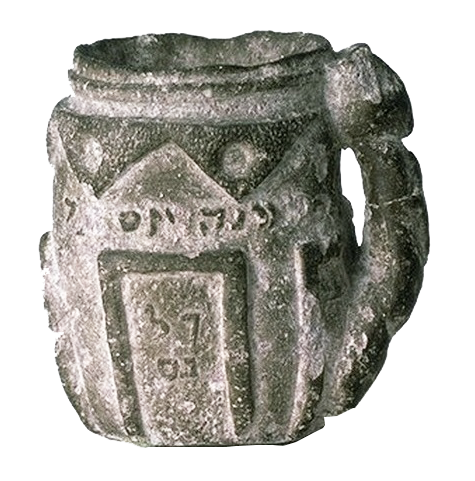
Image opposite: a Purim alms box, 1319, Spain. Museum of Jewish Art and History.
A kind of polygonal «die» marked with numbers has been unearthed, suggesting that the Persians practiced drawing lots, as when Haman casts the lot to determine the date of the genocide (3, 7). The word «lot» (pûr in Persian) explains the name of the Jewish festival of Purim, which to this day remains one of the great extra-biblical festivals.
The holiday is celebrated every year on Adar 14 (which corresponds, depending on the year, to the middle of February or March in the Gregorian calendar). It's a time for revelry and gift-giving, just as in ancient times.
The «Esther Scroll» makes the palace of Xerxes I in Susa the setting for the biblical story; early excavators were tempted to identify the remains unearthed with this story, but the discoveries were too incomplete; ; today it seems likely that the palace of Darius, completed by Xerxes I, restored in 400 BC by Artaxerxes, and briefly occupied by Alexander the Great, is indeed the palace described by the author of the book of’Esther, His description of the gateway, the royal apartments and the gardens is in line with archaeological discoveries.
J Image opposite: the mausoleum attributed, according to tradition, to Esther and Mordecai in Hamadan, Iran. It is also sometimes attributed to Sushan-Dukht, Jewish wife of the Sassanid king Yazdigird (399-420), and is the most important center of Jewish pilgrimage in Iran. Philippe Chavin.
Image opposite: the mausoleum attributed, according to tradition, to Esther and Mordecai in Hamadan, Iran. It is also sometimes attributed to Sushan-Dukht, Jewish wife of the Sassanid king Yazdigird (399-420), and is the most important center of Jewish pilgrimage in Iran. Philippe Chavin.
Nehemiah
Mention of Susa in the book of Nehemiah
The book by Nehemiah also mentions Susa and its citadel.
Nehemiah was a royal cupbearer in the service of the Persian king Artaxerxes I (circa 465-424 B.C.). According to Herodotus, the king drank only water from the river Chaour near Susa; this water, boiled, was transported in silver vases; it had recognized dietetic properties, but if the vessels were reserved for the king's use only, it was also to protect him from poisoning. The same applied to his wine, which was served by the royal cupbearer according to the immutable rules of etiquette. According to the Greek historian Xenophon, «he pours the wine neatly into the cup and, holding it with three fingers, presents it to the drinker in such a way that he can take it very easily»; he also acts as a taster, for «each time he presents the cup to him, drawing from it with the cyath (a small container with a single handle), he pours a few drops into his left hand and swallows them, so that, if he had poured poison, it would not have benefited him». Hence the importance of the royal cupbearer, a position for which men with a reputation for loyalty were chosen, such as Nehemiah at the court of Artaxerxes I (Nehemiah 1,11).
The book by Nehemiah begins with bad news from Jerusalem, describing the poor state of the city walls and the distress of its inhabitants. Nehemiah obtains permission from King Artaxerxes to travel to Jerusalem, with the status of governor of Judea. He visited the city twice.
When he first arrived, he encouraged the people to rebuild the ramparts (Nehemiah 2,17). Nehemiah was forced to arm them because of opposition from the Samaritans, Ammonites and Ashdodians, and to suppress the greed of certain Judeans who oppressed their poor compatriots.
The’Ezra and Nehemiah are linked. Ezra is a «scribe versed in the Law of Moses, given by the Lord, the God of Israel» (Ezra 7,6) his book focuses on rebuilding the Jerusalem Temple, the restoration of the feast of tabernacles and the Law; Nehemiah was responsible for rebuilding the ramparts, which was completed in 52 days (Nehemiah 6,15). Ezra's account includes the name of Zerubbabel (or Scheschbatsar), prince of Judah, to whom Cyrus II hands over all the treasures looted by Nebuchadnezzar II when the Temple was destroyed in 586 BC, to bring them back to Jerusalem (Ezra 1,7-11). We also find the names of Haggai and Zechariah (Ezra 5,1).
Ezra, Nehemiah and Esther form the last three historical books of the Old Testament → in the canon.

